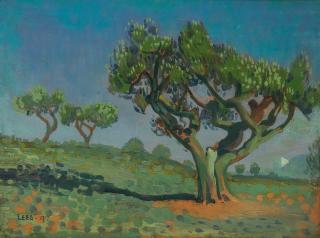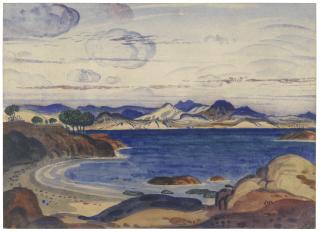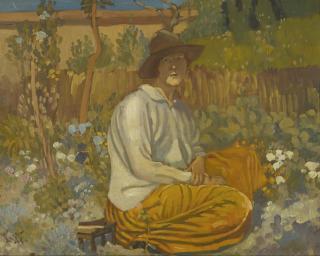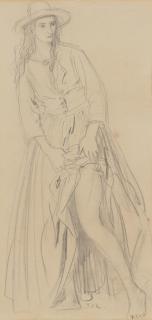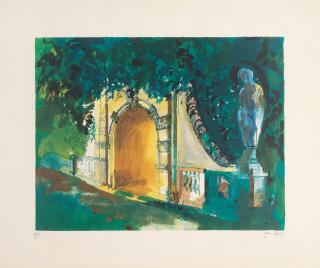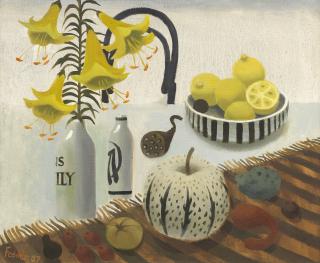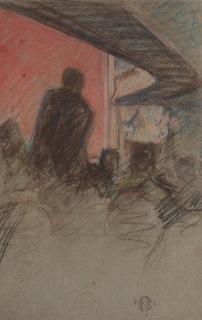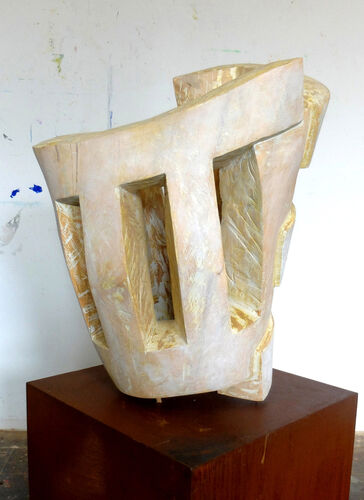Derwent Lees 1884 - 1931
The artist Derwent Lees
- Australian landscape painter of the early 20th century.
- Only Australian artist associated with Fauvism.
- Diagnosis of schizophrenia in 1912 marked the end of his artistic career.
In 1884, the Australian landscape painter saw the light of day under the name Desmond Lees in Hobart, Australia. A stroke of fate clouded his life at an early age: In his youth, he suffered a riding accident that resulted in a head injury and the loss of a foot. Thanks to a wooden prosthetic foot, Lees was able to continue walking.
He came to art when, after a brief stay in Paris, he settled in the English capital, London, in 1905. There he studied at the Slade School of Fine Art with Henry Tonks and Frederick Brown - and subsequently taught at the school for ten years.
Lee's earliest known work dates from this period: it is a pencil drawing from 1909, now privately owned in Doreen, Australia. His friendship with Augustus John and James Dickson Innes clearly influenced the Australian's work. He spent a good two years with the two of them in a cottage at Nant Ddu in North Wales and in 1912 took a trip with them to Collioure in France. It was the time of the beginning of Fauvism, which influenced the three at the time. Lee is now considered the only Australian artist of the movement.
Lee's career had begun to flourish in the 1910s. His work was featured in exhibitions at the Goupil Galleries and Chenil Gallery in Chelsea, the Twentieth Century Art Review Exhibition of 1914, and the Armory Show in New York. In fact, he was the only Australian artist represented there.
In 1912, Lee's ordeal continued: he was diagnosed with schizophrenia, which heralded the end of his artistic career. He spent the period between 1918 and his death in 1931 in an asylum in Surrey.
He eventually died in West Park Hospital in Epsom at the age of 46. Five years after his death, in 1936, the British Pavilion showed his painting Dorset Scene posthumously at the Venice Biennale.
Der Künstler Derwent Lees
- Australischer Landschaftsmaler des frühen 20. Jahrhunderts.
- Einziger australischer Künstler, der mit dem Fauvismus in Verbindung steht.
- Die Diagnose Schizophrenie 1912 markierte das Ende seiner künstlerischen Laufbahn.
1884 erblickte der australische Landschaftsmaler unter dem Namen Desmond Lees in Hobart, Australien, das Licht der Welt. Schon früh trübte ein Schicksalsschlag sein Leben: Im Jugendalter erlitt er einen Reitunfall, der eine Kopfverletzung und den Verlust eines Fußes nach sich zog. Dank einer Fußprothese aus Holz konnte Lees weiterhin laufen.
Zur Kunst kam er, als er sich nach einem kurzen Aufenthalt in Paris 1905 in der englischen Hauptstadt London niederließ. Dort studierte er an der Slade School of Fine Art bei Henry Tonks und Frederick Brown – und unterrichtete im Anschluss für zehn Jahre an der Schule.
Lees frühestes bekanntes Werk stammt aus dieser Zeit: Es ist eine Bleistiftzeichnung von 1909. Sie befindet sich heute im Privatbesitz in Doreen, Australien. Die Freundschaft zu Augustus John und James Dickson Innes prägte das Schaffen des Australiers deutlich. Er verbrachte gut zwei Jahre mit den beiden in einem Cottage in Nant Ddu in Nordwales und unternahm 1912 mit ihnen eine Reise nach Collioure in Frankreich. Es ist die Zeit des beginnenden Fauvismus, der die drei damals beeinflusste. Lee gilt heute als einziger australischer Künstler der Bewegung.
Lees Karriere hatte in den 1910ern begonnen zu florieren. Seine Werke waren auf Ausstellungen in den Goupil Galleries und der Chenil Gallery in Chelsea, der Twentieth Century Art Review Exhibition von 1914 und in der Armory Show in New York zu sehen. Dort war er sogar als einziger australischer Künstler vertreten.
1912 setzte sich Lees Leidensweg fort: Er bekam eine Schizophrenie attestiert, die das Ende seiner künstlerischen Laufbahn einläutete. Die Zeit zwischen 1918 und seinem Tod 1931 verbrachte er in einer Anstalt in Surrey.
Er starb schließlich im West Park Hospital in Epsom im Alter von 46 Jahren. Fünf Jahre nach seinem Tod, im Jahr 1936, zeigte der britische Pavillon sein Gemälde Dorset Scene postum auf der Biennale von Venedig.

